2009 FIAT SEDICI check engine
[x] Cancel search: check enginePage 165 of 270
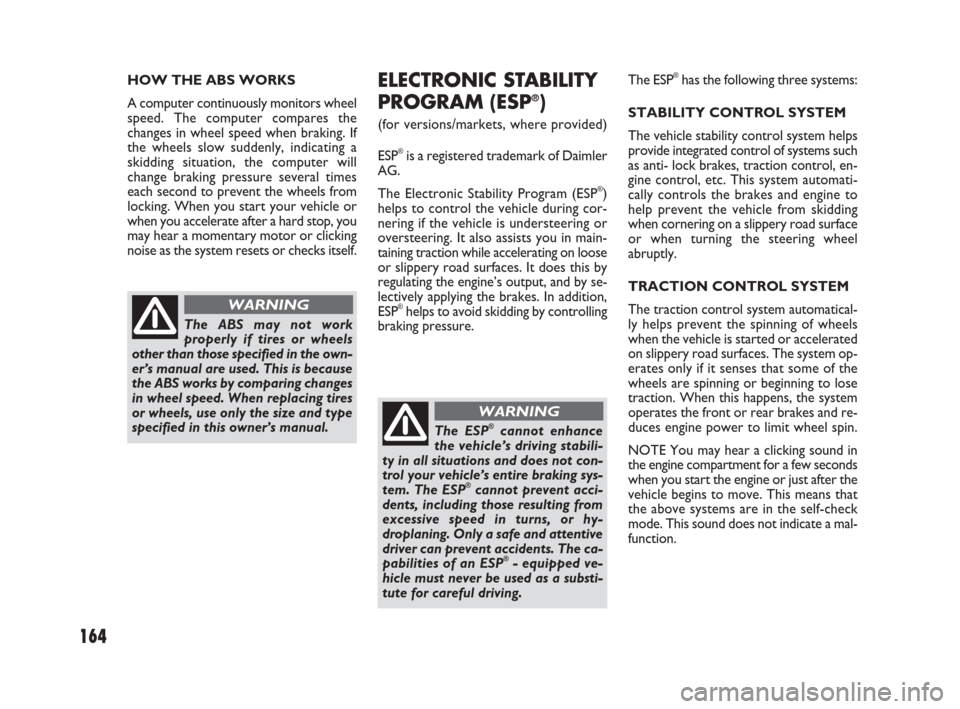
164
HOW THE ABS WORKS
A computer continuously monitors wheel
speed. The computer compares the
changes in wheel speed when braking. If
the wheels slow suddenly, indicating a
skidding situation, the computer will
change braking pressure several times
each second to prevent the wheels from
locking. When you start your vehicle or
when you accelerate after a hard stop, you
may hear a momentary motor or clicking
noise as the system resets or checks itself.
The ABS may not work
properly if tires or wheels
other than those specified in the own-
er’s manual are used. This is because
the ABS works by comparing changes
in wheel speed. When replacing tires
or wheels, use only the size and type
specified in this owner’s manual.
WARNING
ELECTRONIC STABILITY
PROGRAM (ESP®)
(for versions/markets, where provided)
ESP
®is a registered trademark of Daimler
AG.
The Electronic Stability Program (ESP
®)
helps to control the vehicle during cor-
nering if the vehicle is understeering or
oversteering. It also assists you in main-
taining traction while accelerating on loose
or slippery road surfaces. It does this by
regulating the engine’s output, and by se-
lectively applying the brakes. In addition,
ESP
®helps to avoid skidding by controlling
braking pressure.
The ESP®cannot enhance
the vehicle’s driving stabili-
ty in all situations and does not con-
trol your vehicle’s entire braking sys-
tem. The ESP
®cannot prevent acci-
dents, including those resulting from
excessive speed in turns, or hy-
droplaning. Only a safe and attentive
driver can prevent accidents. The ca-
pabilities of an ESP
®- equipped ve-
hicle must never be used as a substi-
tute for careful driving.
WARNING
The ESP®has the following three systems:
STABILITY CONTROL SYSTEM
The vehicle stability control system helps
provide integrated control of systems such
as anti- lock brakes, traction control, en-
gine control, etc. This system automati-
cally controls the brakes and engine to
help prevent the vehicle from skidding
when cornering on a slippery road surface
or when turning the steering wheel
abruptly.
TRACTION CONTROL SYSTEM
The traction control system automatical-
ly helps prevent the spinning of wheels
when the vehicle is started or accelerated
on slippery road surfaces. The system op-
erates only if it senses that some of the
wheels are spinning or beginning to lose
traction. When this happens, the system
operates the front or rear brakes and re-
duces engine power to limit wheel spin.
NOTE You may hear a clicking sound in
the engine compartment for a few seconds
when you start the engine or just after the
vehicle begins to move. This means that
the above systems are in the self-check
mode. This sound does not indicate a mal-
function.
149-168 SEDICI LUM FL GB 1E 19-06-2009 13:33 Pagina 164
Page 176 of 270
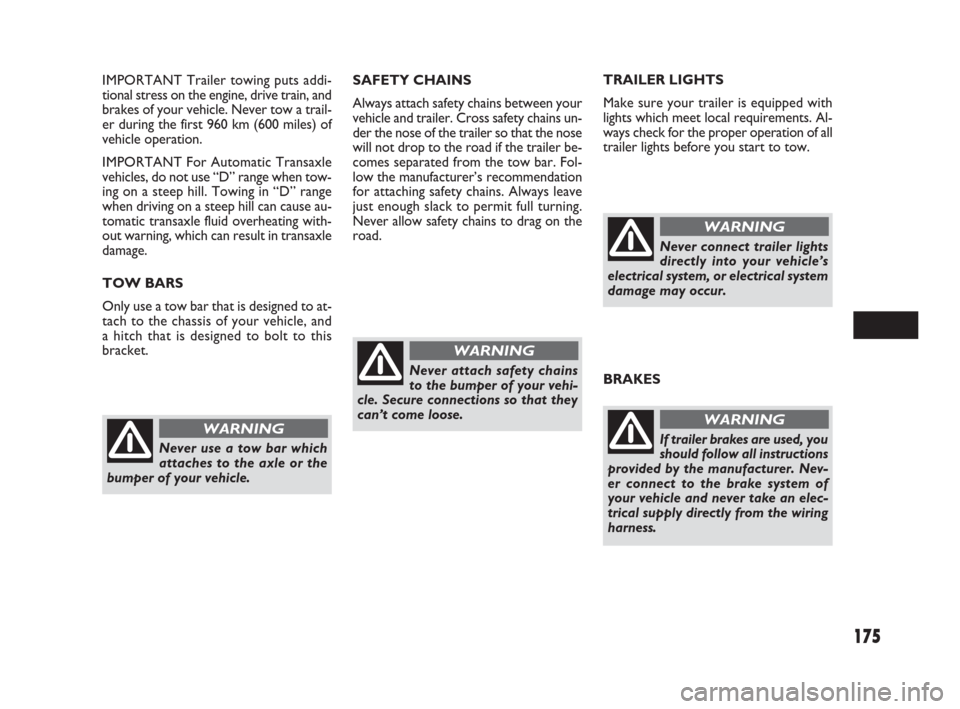
Never use a tow bar which
attaches to the axle or the
bumper of your vehicle.
WARNING
Never attach safety chains
to the bumper of your vehi-
cle. Secure connections so that they
can’t come loose.
WARNING
Never connect trailer lights
directly into your vehicle’s
electrical system, or electrical system
damage may occur.
WARNING
BRAKES
If trailer brakes are used, you
should follow all instructions
provided by the manufacturer. Nev-
er connect to the brake system of
your vehicle and never take an elec-
trical supply directly from the wiring
harness.
WARNING
175
SAFETY CHAINS
Always attach safety chains between your
vehicle and trailer. Cross safety chains un-
der the nose of the trailer so that the nose
will not drop to the road if the trailer be-
comes separated from the tow bar. Fol-
low the manufacturer’s recommendation
for attaching safety chains. Always leave
just enough slack to permit full turning.
Never allow safety chains to drag on the
road.TRAILER LIGHTS
Make sure your trailer is equipped with
lights which meet local requirements. Al-
ways check for the proper operation of all
trailer lights before you start to tow. IMPORTANT Trailer towing puts addi-
tional stress on the engine, drive train, and
brakes of your vehicle. Never tow a trail-
er during the first 960 km (600 miles) of
vehicle operation.
IMPORTANT For Automatic Transaxle
vehicles, do not use “D” range when tow-
ing on a steep hill. Towing in “D” range
when driving on a steep hill can cause au-
tomatic transaxle fluid overheating with-
out warning, which can result in transaxle
damage.
TOW BARS
Only use a tow bar that is designed to at-
tach to the chassis of your vehicle, and
a hitch that is designed to bolt to this
bracket.
173-182 SEDICI LUM FL GB 1E 19-06-2009 10:49 Pagina 175
Page 187 of 270
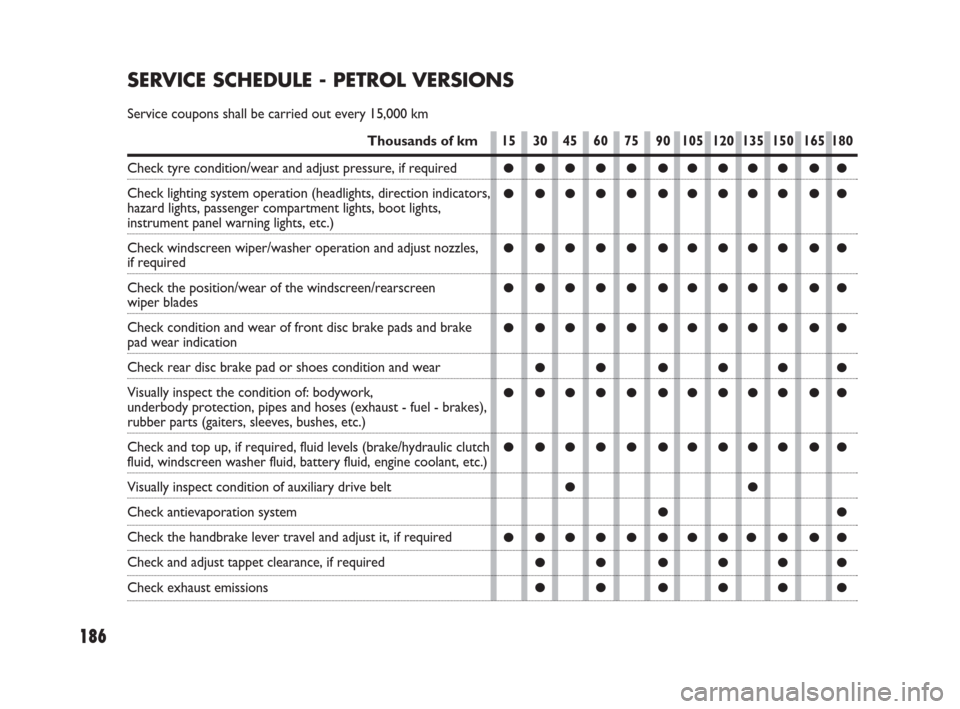
186
15 30 45 60 75 90 105 120 135 150 165 180
●●●●●●●●●●●●
●●●●●●●●●●●●
●●●●●●●●●●●●
●●●●●●●●●●●●
●●●●●●●●●●●●
●● ●●●●
●●●●●●●●●●●●
●●●●●●●●●●●●
●●
●●
●●●●●●●●●●●●
●● ●●●●
●● ●●●●
SERVICE SCHEDULE - PETROL VERSIONS
Service coupons shall be carried out every 15,000 km
Thousands of km
Check tyre condition/wear and adjust pressure, if required
Check lighting system operation (headlights, direction indicators,
hazard lights, passenger compartment lights, boot lights,
instrument panel warning lights, etc.)
Check windscreen wiper/washer operation and adjust nozzles,
if required
Check the position/wear of the windscreen/rearscreen
wiper blades
Check condition and wear of front disc brake pads and brake
pad wear indication
Check rear disc brake pad or shoes condition and wear
Visually inspect the condition of: bodywork,
underbody protection, pipes and hoses (exhaust - fuel - brakes),
rubber parts (gaiters, sleeves, bushes, etc.)
Check and top up, if required, fluid levels (brake/hydraulic clutch
fluid, windscreen washer fluid, battery fluid, engine coolant, etc.)
Visually inspect condition of auxiliary drive belt
Check antievaporation system
Check the handbrake lever travel and adjust it, if required
Check and adjust tappet clearance, if required
Check exhaust emissions
183-230 SEDICI LUM FL GB 1E 19-06-2009 11:00 Pagina 186
Page 188 of 270

187
15 30 45 60 75 90 105 120 135 150 165 180
●●●●●●●●●●●●
●●●●
●●●●●●●●●●●●
●● ●● ●● ●●
●●●●
●●●●
●●
●●●●
●
●● ●●●
●●●●
●
●●●●●●
●● ●●
●
●● ●●●●
●● ●●●●
●● ●●●●
●● ●●●●
●● ●●●●
Thousands of km
Check cleanliness of locks, bonnet and boot, and cleanliness
and lubrication of linkages
Replace spark plugs (replace iridium spark plugs
every 105,000 km) or every 7 years
Change engine oil and oil filter
Check air cleaner conditions
Replace air filter cartridge
Change engine coolant
Replace auxiliary drive belt
Sight inspect fuel tank conditions
Check manual transaxle gear oil level
Check automatic transaxle gear oil level
Change manual transaxle gear oil
Change automatic transaxle gear oil
Check transmission unit oil level (4x4 version)
Check rear differential oil level (4x4 version)
Change rear differential oil (4x4 version)
(just the first time at 15,000 km)
Check suspension operation
Check steering system
Check engine management system operation
(via diagnostic socket)
Change brake and clutch fluid (or every 2 years)
Replace pollen filter (or every 2 years)
183-230 SEDICI LUM FL GB 1E 19-06-2009 11:00 Pagina 187
Page 189 of 270
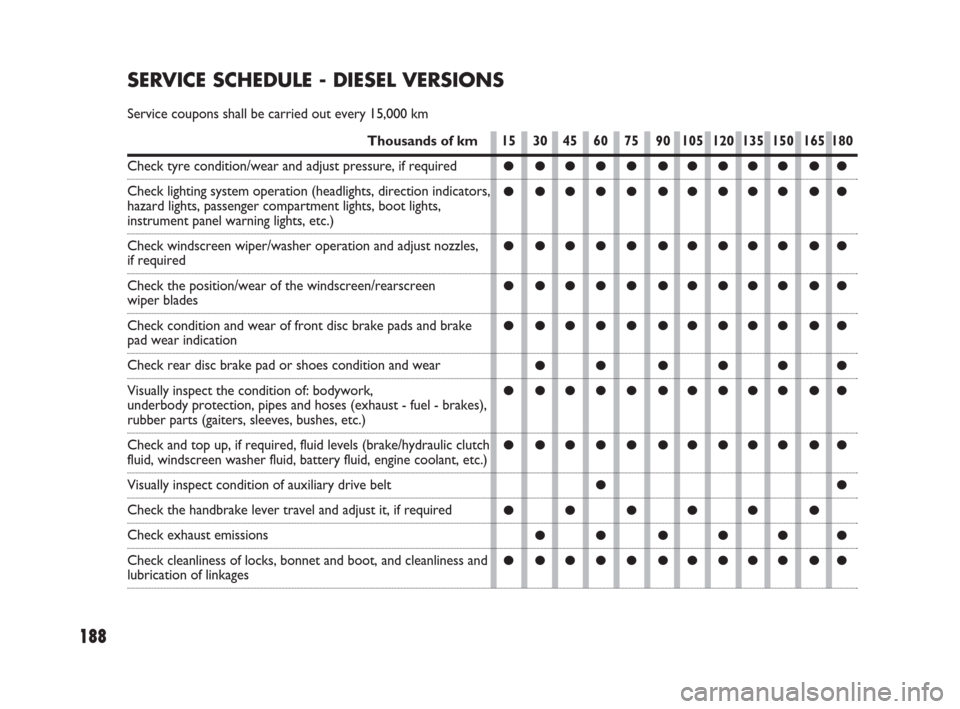
188
15 30 45 60 75 90 105 120 135 150 165 180
●●●●●●●●●●●●
●●●●●●●●●●●●
●●●●●●●●●●●●
●●●●●●●●●●●●
●●●●●●●●●●●●
●● ●●●●
●●●●●●●●●●●●
●●●●●●●●●●●●
●●
●●●●●●
●● ●●●●
●●●●●●●●●●●●
SERVICE SCHEDULE - DIESEL VERSIONS
Service coupons shall be carried out every 15,000 km
Thousands of km
Check tyre condition/wear and adjust pressure, if required
Check lighting system operation (headlights, direction indicators,
hazard lights, passenger compartment lights, boot lights,
instrument panel warning lights, etc.)
Check windscreen wiper/washer operation and adjust nozzles,
if required
Check the position/wear of the windscreen/rearscreen
wiper blades
Check condition and wear of front disc brake pads and brake
pad wear indication
Check rear disc brake pad or shoes condition and wear
Visually inspect the condition of: bodywork,
underbody protection, pipes and hoses (exhaust - fuel - brakes),
rubber parts (gaiters, sleeves, bushes, etc.)
Check and top up, if required, fluid levels (brake/hydraulic clutch
fluid, windscreen washer fluid, battery fluid, engine coolant, etc.)
Visually inspect condition of auxiliary drive belt
Check the handbrake lever travel and adjust it, if required
Check exhaust emissions
Check cleanliness of locks, bonnet and boot, and cleanliness and
lubrication of linkages
183-230 SEDICI LUM FL GB 1E 19-06-2009 11:00 Pagina 188
Page 190 of 270
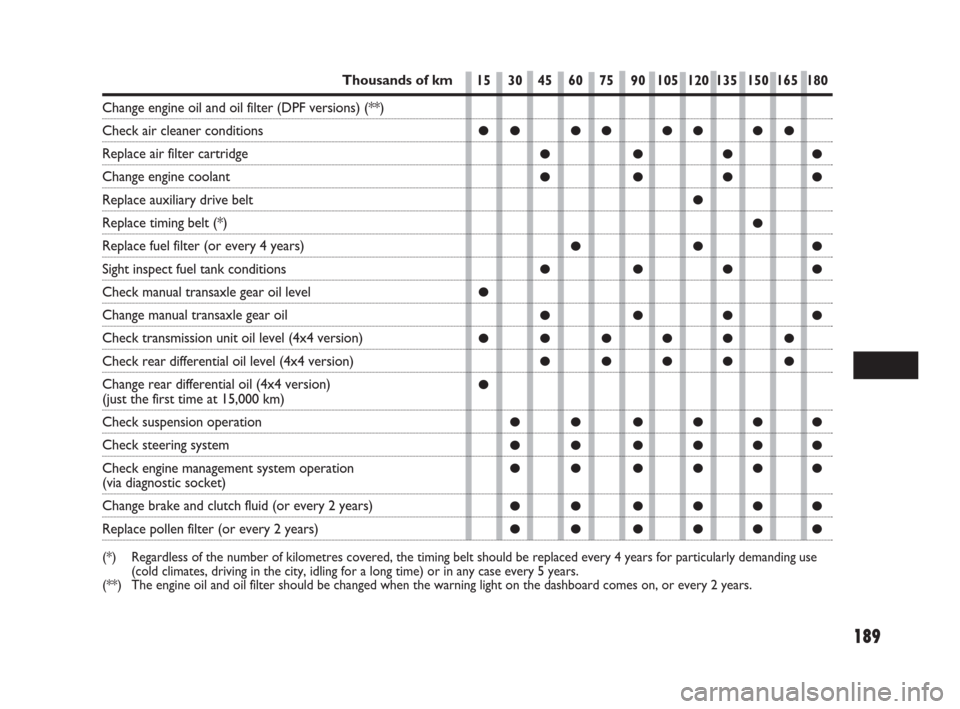
189
15 30 45 60 75 90 105 120 135 150 165 180
●● ●● ●● ●●
●●●●
●●●●
●
●
●●●
●●●●
●
●●●●
●●●●●●
●●●●●
●
●● ●●●●
●● ●●●●
●● ●●●●
●● ●●●●
●● ●●●●
Thousands of km
Change engine oil and oil filter (DPF versions) (**)
Check air cleaner conditions
Replace air filter cartridge
Change engine coolant
Replace auxiliary drive belt
Replace timing belt (*)
Replace fuel filter (or every 4 years)
Sight inspect fuel tank conditions
Check manual transaxle gear oil level
Change manual transaxle gear oil
Check transmission unit oil level (4x4 version)
Check rear differential oil level (4x4 version)
Change rear differential oil (4x4 version)
(just the first time at 15,000 km)
Check suspension operation
Check steering system
Check engine management system operation
(via diagnostic socket)
Change brake and clutch fluid (or every 2 years)
Replace pollen filter (or every 2 years)
(*) Regardless of the number of kilometres covered, the timing belt should be replaced every 4 years for particularly demanding use
(cold climates, driving in the city, idling for a long time) or in any case every 5 years.
(**) The engine oil and oil filter should be changed when the warning light on the dashboard comes on, or every 2 years.
183-230 SEDICI LUM FL GB 1E 19-06-2009 11:00 Pagina 189
Page 192 of 270
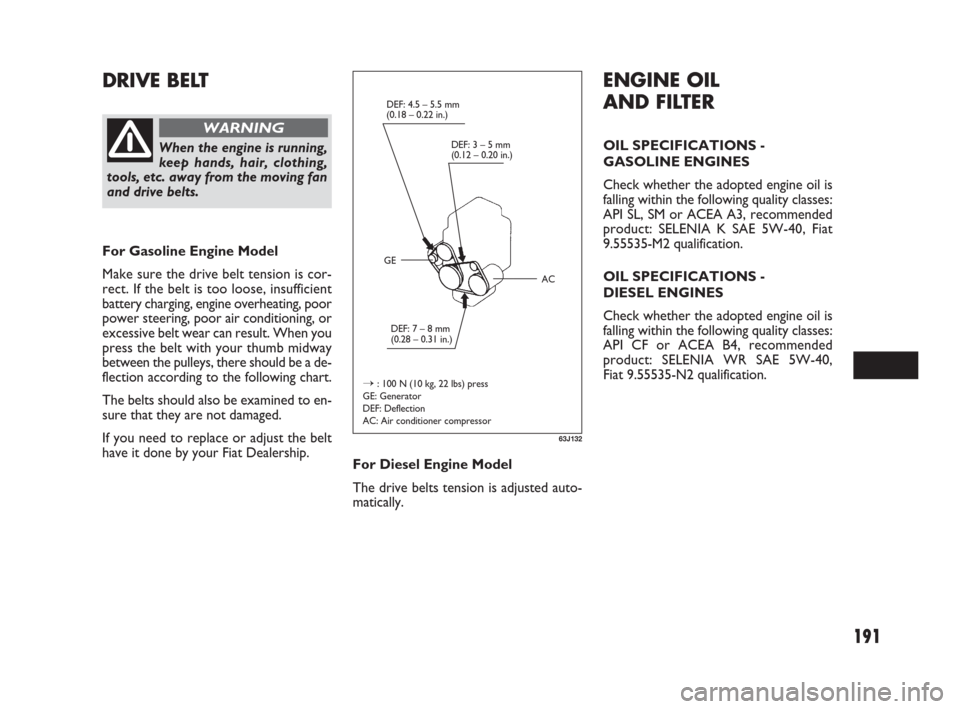
191
ENGINE OIL
AND FILTER
OIL SPECIFICATIONS -
GASOLINE ENGINES
Check whether the adopted engine oil is
falling within the following quality classes:
API SL, SM or ACEA A3, recommended
product: SELENIA K SAE 5W-40, Fiat
9.55535-M2 qualification.
OIL SPECIFICATIONS -
DIESEL ENGINES
Check whether the adopted engine oil is
falling within the following quality classes:
API CF or ACEA B4, recommended
product: SELENIA WR SAE 5W-40,
Fiat 9.55535-N2 qualification.
DRIVE BELT
63J132
DEF: 4.5 – 5.5 mm
(0.18 – 0.22 in.)
DEF: 3 – 5 mm
(0.12 – 0.20 in.)
DEF: 7 – 8 mm
(0.28 – 0.31 in.)
AC GE
→: 100 N (10 kg, 22 lbs) press
GE: Generator
DEF: Deflection
AC: Air conditioner compressor
When the engine is running,
keep hands, hair, clothing,
tools, etc. away from the moving fan
and drive belts.
WARNING
For Gasoline Engine Model
Make sure the drive belt tension is cor-
rect. If the belt is too loose, insufficient
battery charging, engine overheating, poor
power steering, poor air conditioning, or
excessive belt wear can result. When you
press the belt with your thumb midway
between the pulleys, there should be a de-
flection according to the following chart.
The belts should also be examined to en-
sure that they are not damaged.
If you need to replace or adjust the belt
have it done by your Fiat Dealership.
For Diesel Engine Model
The drive belts tension is adjusted auto-
matically.
183-230 SEDICI LUM FL GB 1E 19-06-2009 11:00 Pagina 191
Page 193 of 270

192
1.MIN
2.MAX
3.Engine oil dipstick
IMPORTANT Failure to check the oil lev-
el regularly could lead to serious engine
trouble due to insufficient oil.REFILLING
Remove the oil filler cap and pour oil
slowly through the filler hole to bring the
oil level to the upper limit on the dipstick.
Be careful not to overfill. Too much oil is
almost as bad as too little oil. After refill-
ing, start the engine and allow it to idle for
about a minute. Stop the engine, wait
about 5 minutes and check the oil level
again. OIL LEVEL CHECK
It is important to keep the engine oil at the
correct level for proper lubrication of
your vehicle’s engine. Check the oil level
with the vehicle on a level surface. The oil
level indication may be inaccurate if the
vehicle is on a slope. The oil level should
be checked either before starting the en-
gine or at least 5 minutes after stopping
the engine.
The handle of the engine oil dipstick is col-
ored yellow for easy identification. Pull out
the oil dipstick, wipe oil off with a clean
cloth, insert the dipstick all the way into
the engine, then remove it again. The oil
on the stick should be between the upper
and lower limits shown on the stick. If the
oil level indication is near the lower limit,
add enough oil to raise the level to the up-
per limit.
80G06481A147
Open
Close
For Gasoline Engine Model
(3)
(2) (1)
79J170
For Diesel Engine Model
183-230 SEDICI LUM FL GB 1E 19-06-2009 11:00 Pagina 192